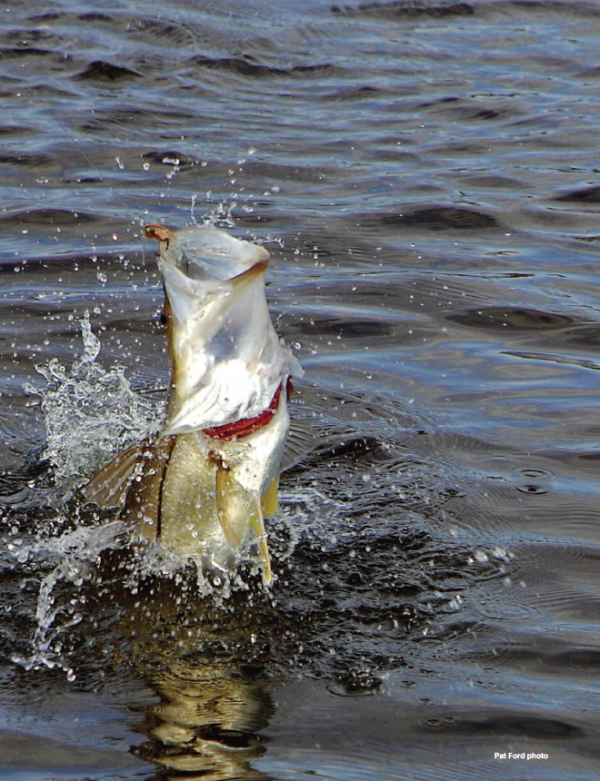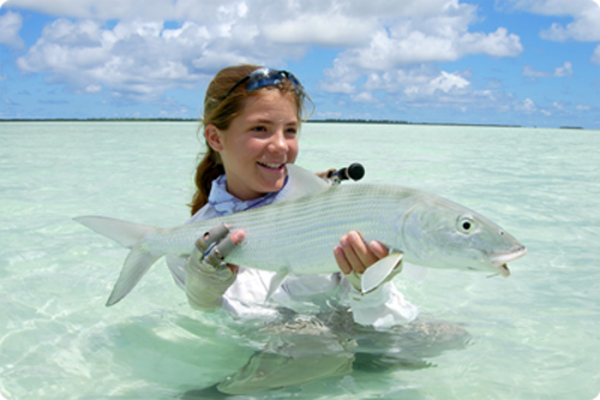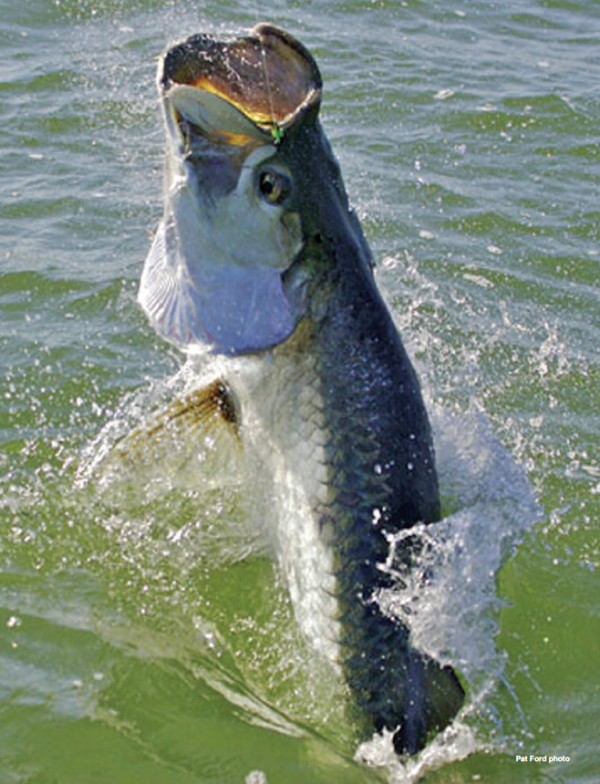 By Aaron Adams: How Fish use sight and sound
By Aaron Adams: How Fish use sight and sound
[dropcap]M[/dropcap]any anglers make assumptions about what fish see and hear, and many of these assumptions are wrong. I’ve been told, for example, in no uncertain terms, that fish can’t see color. This is not true. For every species of fish tested of which I am aware, each one can see colors. But different species of fish often see different portions of the light spectrum, and some fish can see portions of the light spectrum that we can not, such as ultraviolet wavelengths of light. Therefore, knowing what colors can be seen by your favorite gamefish is important for designing and selecting flies and lures.
Similarly, since fish don’t have external ears, many people think they can’t hear. This is also not true. Sound travels very well inwater, so hearing is very important for fishes, both to find prey and to avoid predators. Understanding how fish detect sound, and how sound travels through water can also be useful in creation and selection of flies, as well as for strategizing how flies are fished under different conditions.
Although there has been no research on visionand hearing abilities of bonefish, tarpon, or permit, we can use what we know about fish vision and hearing to help with how we approach fishing for these rock stars of the flats.
Basics of Light in Water
Visible light (the portion of the light spectrum that we are able to see) is composed ofmany different colors. The general makeup of these colors is red, orange, yellow, green, blue, indigo, and violet, plus all of the small transitions in between. Beyond either end of the visible spectrum are wavelengths of light that we are unable to see – infra-red on the outer end of the red end of the light spectrum, and ultraviolet past the violet end of the spectrum. Each of these colors has different wavelengths, which means they interact differently with the material throughwhich they are passing. The color with thelongest wavelength is red, and wavelengths become shorter toward the violet end of the spectrum.
Wavelength matters because, in general, the longer the wavelength, the faster the light is absorbed in water. But what is in the water also influences the behavior of light.
In clear, open ocean water, and to a lesser extent on tropical flats, the color red is no longer visible deeper than about 20’. Orange and yellow are lost soon after. By the time a depth of 30 feet is reached, blue and violet are pretty much the only colors left. In deep water, everything takes on shades of gray and black.
The behavior of light differs, however, in coastal and estuarine waters. Many coastal waters contain a lot of plankton, which absorbs short wavelength light (such as blue), and longer wavelengths are absorbed by the water. This leaves green as the dominant color remaining in coastal waters because it
penetrates to the greatest depth. In coastal waters with a lot of suspended particles, estuaries for example, green is also absorbed and scattered, which leaves red, orange, and yellow as dominant remaining light wavelengths, at least as far as they can penetrateinto the water.
These patterns of color attenuation also occur horizontally. So even if a red fly is within a foot of the surface, where red is still a visible color, a fish that is 20 feet or more away from the fly won’t see the color red. This is because light is attenuated when it passes through water whether in a vertical or horizontal direction. A little further away and orange won’t show up, and so on. This is a big consideration when choosing colors for flies – how far away will the fish be when you make your fly presentation?
Light is also lost over distance (attenuated) by scattering and absorption by objects. For example, some light is reflected by particles that are suspended in the water. This reduces the amount of light that continues to pass through the water, so reduces the intensity of the light at greater depth. Other light is absorbed by objects, such as rocks, and the light is converted into heat. Light is also absorbedby plankton, which uses it for photosynthesis. And still more light is absorbed by the water, which once again is converted to heat. At one extreme, in murky, planktonfilled coastal waters, light doesn’t penetrate very far. At the other extreme, in tropical oceans light penetrates for hundreds of feet.
The scattering of light by particles is an important concept to understand, even when fishing apparently crystal clear waters of a bonefish flat. Often, water that seems to be gin clear from the surface is not so when viewed from below. This is because the light that enters the water reflects off suspended particles, scattering light in all directions. This results in decreased horizontal visibility. So although you might be able to see a fish clearly from above, the fish might not have as good a view of your fly as you think.
The scattering of light presents even more of a challenge in murky or muddy water. There are so many particles in the water that light is reflected in all directions, making visibility very difficult. To get a better grasp of this, think about driving trough a fog bank at night. You can see more with your low beam headlights on because less light is being scattered through the fog than when you have the high beams on.
Dark objects tend to show up best in murky water conditions because they provide the maximum contrast against the otherwise murky, backlit background against which a light colored object won’t stand out. This is a major reason that black flies and lures are productive in murky water.
As light hits the water surface, some is reflected back into the air, and some enters the water. The amount of light that enters the water tends to be greater on days with waves than days that are flat calm. This may seem counterintuitive – after all, days with waves or chop can produce a lot of glare that is tough for an angler to see through. But the glare the angler experiences has more to do with the angle at which the light hits thewater in relation to the angler than it does with how much light is entering the water.
When light enters the water, it is refracted (in a sense, it is bent). This is because air and water are different densities, so light travels faster in air than in water. When the angle of the water surface changes in relation to incoming light, such as on a wavy water surface, the relative angles that the light are refracted change, which creates the undulating motion of light and shadow underwater.
The amount of light play underwater can have an influence on how well objects, such as flies and lures, are seen by fish. In general, I think that on days with wave action it is harder for fish to see small objects – they can become lost in the mix of light and shadow that results from the refraction of light through the multiple angles of the water surface. So on days with wave action, try using larger flies or lures. In contrast, on calm days when there is less underwater light play because the light is being refracted at mostly the same angle, small flies and lures may be more appropriate.
Basics of Sound in Water
Sound is more important in water than most anglers realize. The densities of water and air are too different for most sound to travel from one to the other, so anglers on a boat or wading are oblivious to most of the noise that exists below the water surface. Similarly, fish are generally unaware of sound traveling through the air above them.
A sound wave is a pressure wave that displaces particles as it travls through air, water, or other medium. Sound in water travels about 4.5 times faster (and also travels farther) than in air. Low frequency sounds tend to travel farther than high frequency sounds. This means that the noise made by dropping a reel on the deck of the boat is detected almost immediately by fish within a significant radius of the boat – the boat hull acts as an amplifier, and since it is in the water, the sound of banging against its hull is transmitted through the water.
Pressure waves are also generated by objects moving through the water – whether a swimming fish, a scurrying prey, a moving boat, or wading angler. These waves travel through the water in the same fashion as sound waves. This is why stealthy anglers are more successful than those who move quickly across the flat, pushing a wave of water as they move. This also explains why a fish reacts to a fly or lure that plops loudly into the water.
When sound travels through water, its intensity diminishes with distance. This is because it is weakened by scattering and absorp- tion. Scattering is the reflection of the sound wave in directions other than its original direction of movement. This can be caused by structures such as rocks, and by the bottom or water surface, both of which are different densities than water. This is especially true in shallow water, where the bottom and water surface are close to one another, which greatly limits the distance that a sound wave can travel in these shallow habitats. In deeper waters the bottom and water surface aren’t as influential, and sound can travel farther. Absorption is the conversion of the sound energy to other forms of energy, and doesn’t differ between shallow and deeper water.
Fish Hearing
The propagation of sound and other pressure waves in water means that detection of these waves is an essential characteristic possessed by gamefish, their prey, and their
predators. Fish have two means for detecting these sound and pressure waves – an inner ear and a lateral line.
A fish’s inner ear is composed of a series of fluid filled canals and chambers. The inner walls of the chambers are lined by cells with cilia – hair-like extensions that protrude into the chamber. In these chambers are small bones, called otoliths. As an otolith moves around in a chamber, the cilia detect the movements and send a signal to the brain.
As a sound wave travels from the water to the otolith, it is moving between substances that have different densities (water and bone). This causes the sound wave to change shape, and causes the otoliths to vibrate. Thevibration of the otoliths stimulates the cilia, which sends a message to the brain. The sound waves traveling through the fluidwithin the inner ear can also be detected. The brain then has to determine whether the sound is of consequence, and whether it is from a prey or predator.
Many fish are also able to use their air-filled swim bladders to increase their hearing ability. The air within the swim bladder is compressed by the sound waves, so is more sensitive than the inner ear. In many fish the swim bladder is connected to the inner ear, which allows the air bladder to act as an amplifier of sound. Even in many fish without a direct connection between the swim bladder and inner ear, an extension of the swim bladder is close enough to the inner ear to at least partially amplify sound. The inner ear system of fish is good at detecting sounds atboth close range (30 feet or so) as well as from distant sources (a mile or more in the open ocean).
A great compliment to the inner ear system is the lateral line system. The lateral line is a series of pores through which specialized cells extend. The lateral line extends along the length of the fish, from just behind the head to the base of the tail. Sticking through the pores are specialized cells, called neuromasts, that contain sensory cells embedded in a jelly-filled casing called a capula, which extends into the pore. As pressure wave pass over the fish, the capula is moved, which in turn moves the sensory hairs within it, which sends a signal to the brain. The lateral line is good at detecting pressure waves from near sources, 30 feet or less.
A better understanding of how light and sound behave in water, and how fish are able to see and hear, should already have you thinking about new and better approaches to presenting flies and lures, and how to approach fish in different conditions. When we’re out on the water we are in the fishes’ realm, so the more we know about what makes them tick the better anglers we will become.
[information]
www.tarbone.org
fishermanscoast.com/ A comprehensive guide for the angler who wants to know more and be a better fisher-person.
Bonefish & Tarpon Trust
24 Dockside Lane
PMB 83
Key Largo, FL, 33037
(239) 283-4733
[/information]










